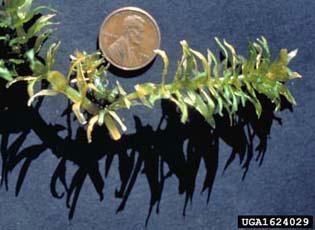Hydrilla verticillata (L. f.) Royle (ITIS)
Hydrilla, Florida elodea, water thyme, Indian star-vine
Eastern Hemisphere; U.S. strains possibly originated in Asia (Balciunas et al. 2002)
1950s (Balciunas et al. 2002)
Aquarium trade (Balciunas et al. 2002)
Crowds out native species; impedes irrigation and boating (Balciunas et al. 2002)

Hydrilla, plants
Photo by Raghavan Charudattan; University of Florida
Find more images
Spotlights
Distribution / Maps / Survey Status
Federally Regulated
Videos
All Resources
Selected Resources
The section below contains highly relevant resources for this species, organized by source.
Council or Task Force
Partnership
Federal Government
State and Local Government
Academic
Balciunas, J.K., M. J. Grodowitz, A.F. Cofrancesco and J.F. Shearer. 2002. Hydrilla. In: R. Van Driesche et al. (Eds.), Biological control of invasive plants in the eastern United States (FHTET-2002-04). Morgantown, West Virginia: U.S. Forest Service Forest Health Technology Enterprise Team.
Integrated Taxonomic Information System. Hydrilla verticillata. [Accessed Sep 16, 2023].
